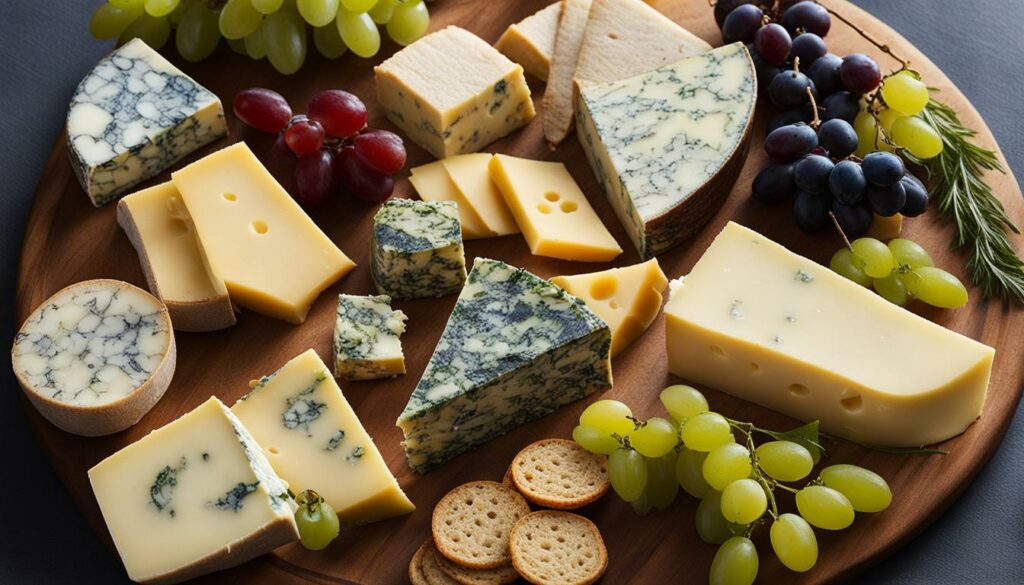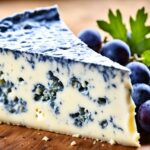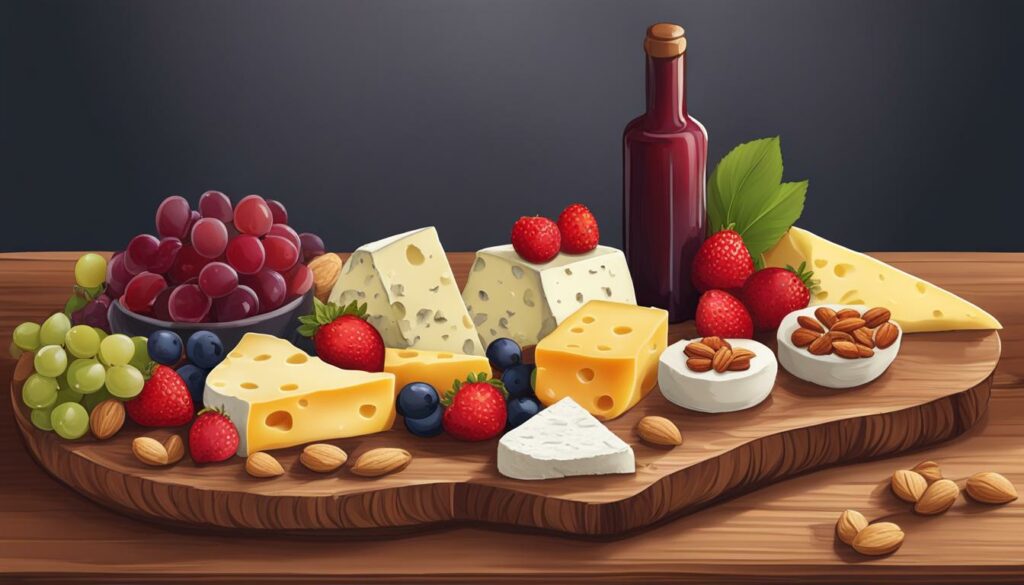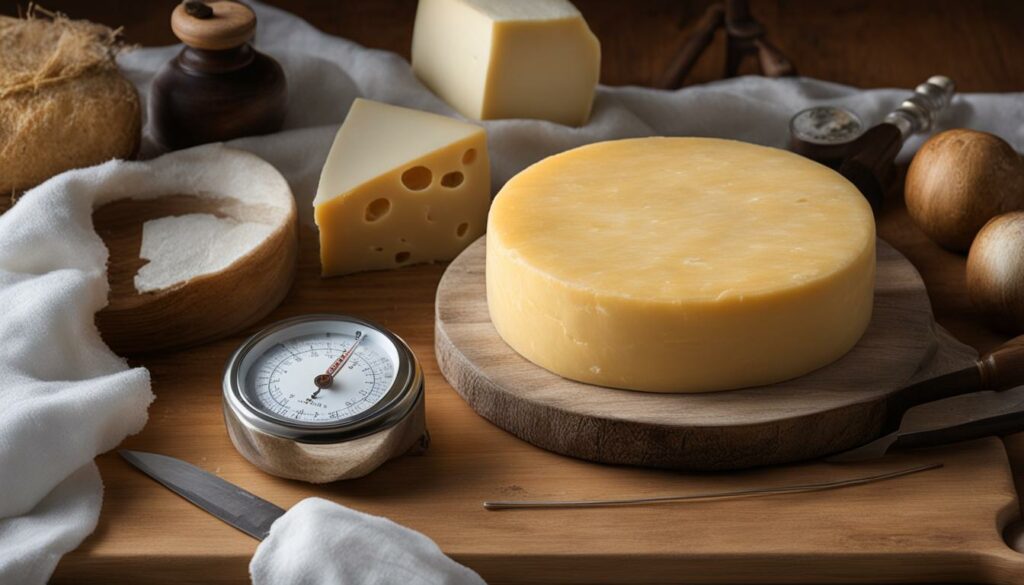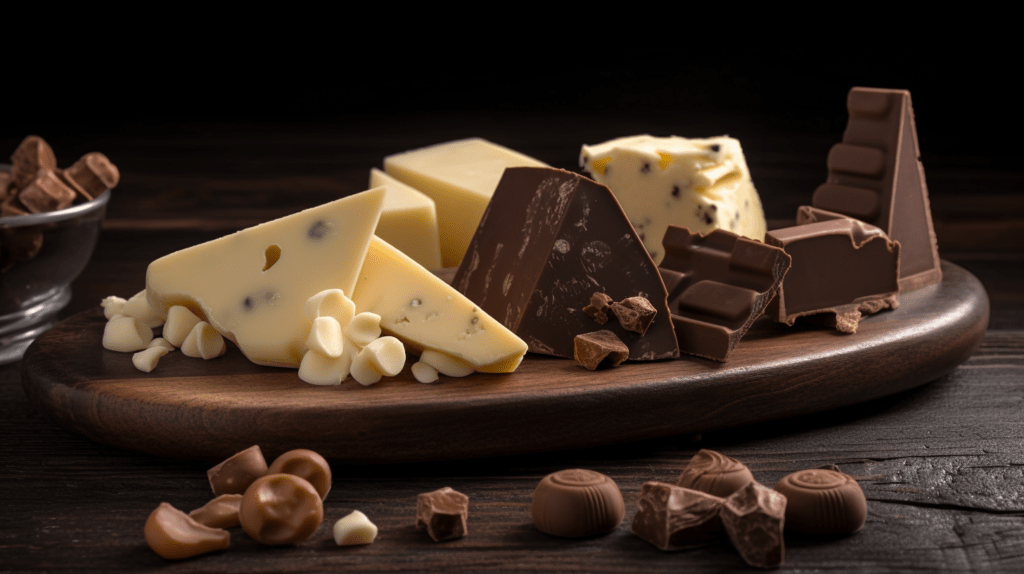Blue cheese is a diverse and often misunderstood category of cheese. It can be strongly flavored and punchy, which can intimidate some people. However, there is a wide variety of blue cheeses available, each with its own unique flavor profile. In this article, we will explore some of the best blue vein cheese selections, including Roquefort Cheese, Gorgonzola Cheese, Stilton Cheese, Danish Blue Cheese, Cambozola Cheese, Fourme d’Ambert Cheese, Cashel Blue Cheese, Maytag Blue Cheese, and Bleu d’Auvergne Cheese. These cheeses are all excellent options for blue cheese lovers or those looking to try blue cheese for the first time.
What You Need to Know About Blue Cheese
Blue cheese is a unique style of cheese that is manufactured according to specific regulations. It is not just a synonym for blue cheese; it is a specific type of cheese. Blue cheese is made using certain molds, such as Penicillium roqueforti, which give it its distinctive blue veining.
Blue cheese can be used in cooking or enjoyed on a blue cheese plate alongside other complementary flavors. Many people who love other styles of cheese may have yet to find a blue cheese they enjoy, so it’s important to try different varieties to find the right one for your taste.

The Origins and Science of Blue Cheese
The origins of blue cheese are shrouded in legend and myth, but the true story of how blue cheese was created is still uncertain. Blue cheeses get their distinctive flavor and veining from molds like Penicillium roqueforti or glaucum. These molds break down the fat within the cheese, creating different compounds that contribute to the flavor and aroma. There are different species of Penicillium fungi that can be used in the making of blue cheese, resulting in a wide range of flavors.
Cheesemakers introduce the mold through either piercing or rubbing the cheese, and the aging process determines the final taste and texture. The mold spores are introduced into the cheese at the beginning of the cheesemaking process, and as the cheese ages, the mold grows and develops, infusing the cheese with its characteristic blue veins.
One of the most common molds used in blue cheese production is Penicillium roqueforti. This mold is responsible for the distinctive flavor and aroma of blue cheese. It breaks down the fats in the cheese, producing compounds that give blue cheese its sharp and tangy taste.
Another type of mold that can be used in blue cheese production is Penicillium glaucum. This mold produces a milder flavor and is often used in softer blue cheeses.
The science behind the creation of blue cheese is fascinating. The specific conditions required for mold growth, including temperature, humidity, and oxygen levels, must be carefully controlled to ensure the desired flavor and veining in the cheese.
Blue cheese is a prime example of how science and art come together to create a culinary masterpiece. The delicate balance between the cheese, the mold, and the aging process results in a cheese with a truly unique flavor and texture.
The final taste and texture of blue cheese are also influenced by other factors such as the type of milk used, the length of aging, and the cheesemaking techniques employed. Each cheesemaker has their own secrets and techniques for creating the perfect blue cheese.
Blue Cheese Mold Comparison
| Mold Type | Flavor Profile | Common Cheeses |
|---|---|---|
| Penicillium roqueforti | Sharp, tangy, and piquant | Roquefort, Stilton, Gorgonzola |
| Penicillium glaucum | Milder, more buttery | Bleu d’Auvergne, Bavarian Blue |
These cheese molds are the key to creating the unique flavors and textures that make blue cheese so beloved by cheese enthusiasts around the world. Whether you prefer a bold and tangy blue cheese or a milder and creamier option, there is a blue cheese out there to suit your taste.
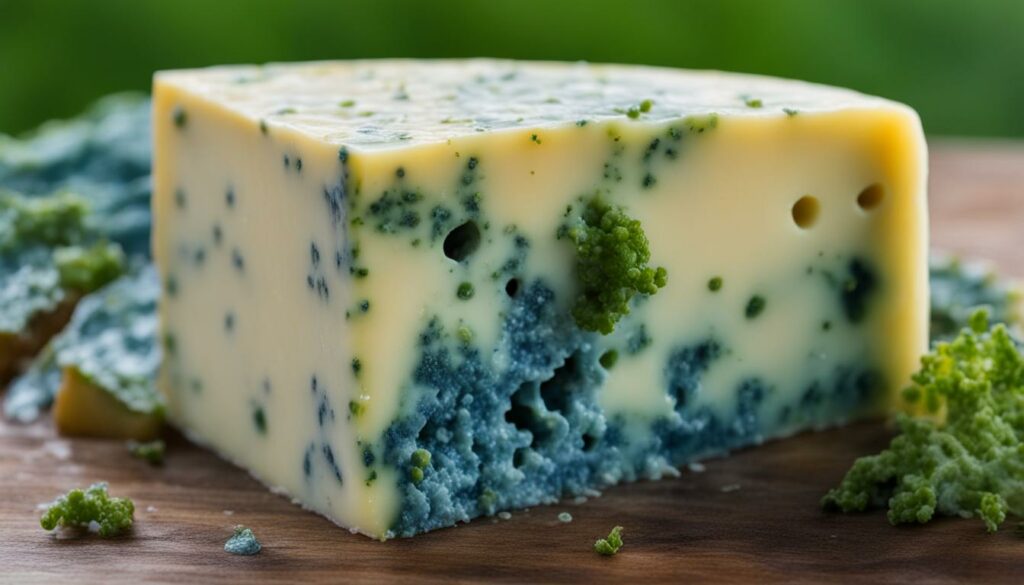
Different Types of Blue Cheese
Blue cheese offers a diverse range of flavors and textures, catering to various taste preferences. Whether you prefer a crumbly, piquant variety or a milder, creamier option, there is a blue cheese out there that’s perfect for you. Exploring different types of blue cheese allows you to appreciate the unique characteristics each variety has to offer. Additionally, blue cheese is just one example of the many moldy cheese options available, providing a world of exploration for cheese enthusiasts.
When it comes to blue cheese varieties, there are several factors to consider. Some people may gravitate towards the boldness of crumbly blue cheeses, which have a stronger flavor profile and a drier texture. These cheeses can be overwhelming to some, but they can also be incredibly satisfying for those seeking an intense blue cheese experience.
If you prefer a milder blue cheese, creamy varieties might be more suitable for your palate. These cheeses are often softer in texture, with a smoother and less pungent taste. Mild blue cheeses tend to be more approachable for those who are new to blue cheese or prefer a subtler flavor.
It’s worth mentioning that moldy cheese extends beyond blue cheese alone. There are countless other cheese varieties that derive their unique flavors from molds. Exploring different moldy cheese options opens up a whole world of cheese tasting possibilities.
Different Blue Cheese Varieties
Here are some popular blue cheese varieties that you might consider trying:
| Cheese | Texture | Flavor |
|---|---|---|
| Roquefort | Crumbly | Strong and tangy |
| Gorgonzola | Creamy | Rich and slightly sweet |
| Stilton | Crumbly | Sharp and robust |
| Danish Blue | Creamy | Mild and buttery |
Remember, it’s always a good idea to start with milder blue cheeses if you’re new to blue cheese or prefer a more subtle flavor. Gradually experiment with different varieties, textures, and flavor profiles to discover your personal favorites.
Must-Try Blue Cheeses from Wisconsin
Wisconsin is renowned for its exceptional blue cheeses, and there are several must-try options from this region. The state’s rich dairy heritage and commitment to craftsmanship result in a selection of blue cheeses that are sure to delight any cheese connoisseur.
Roth Buttermilk Blue
If you’re new to blue cheese or prefer milder flavors, Roth Buttermilk Blue is the perfect choice. This cheese offers a delicate balance of tanginess and creaminess, making it an excellent gateway into the world of blue cheese. The subtle blue veining adds a touch of complexity without overwhelming the palate.
Deer Creek The Blue Jay
For those seeking a unique twist on traditional blue cheese, Deer Creek The Blue Jay is a standout option. Infused with crushed juniper berries, this cheese boasts a creamy and smooth texture with a hint of botanical flavors. It’s a perfect choice for those looking to explore more adventurous blue cheeses.
Hook’s Original Blue
Hook’s Original Blue is a blue cheese that strikes the ideal balance between bold flavors and subtle sweetness. Aged for just over 12 months, this cheese develops a complex profile that appeals to both blue cheese enthusiasts and newcomers alike. Its rich and creamy texture make it a versatile choice for various culinary applications.
Carr Valley Glacier Penta Creme
Carr Valley Glacier Penta Creme is an indulgent blue cheese that offers a velvety smooth texture and an extra touch of creaminess. The addition of cream creates a luscious mouthfeel, while the blue veining adds a distinct tangy flavor profile. This cheese is a true delight for those craving a rich and luxurious blue cheese experience.
These Wisconsin blue cheeses represent a diverse range of flavors and textures, ensuring there’s something to suit every palate. Whether you prefer mild and tangy or bold and creamy blue cheeses, these selections are a testament to the exceptional craftsmanship and dedication to quality found in Wisconsin’s cheese-making traditions.
For all the blue cheese lovers out there, Wisconsin’s offerings are a true treasure trove. Dive into the world of Wisconsin blue cheeses and savor the delectable taste and unique characteristics that this region has to offer.
Exploring the Taste and Pairing of Blue Cheese
Blue cheese offers a distinct taste that is both salty and bright, with hints of funkiness and earthiness. Its bold flavor sets it apart from milder cheeses like cheddar, making it a favorite among cheese enthusiasts. But what makes blue cheese truly special is its versatility in pairing with a wide range of beverages.
The Taste of Blue Cheese
Blue cheese has a unique taste profile that appeals to a variety of palates. Its salty notes provide a pleasant contrast to its bright and tangy flavors. At times, blue cheese can also feature funky or earthy undertones that add depth to its overall taste. If you’re a fan of bold and distinct flavors, blue cheese is sure to satisfy your palate.
Pairing Blue Cheese with Beer
Blue cheese pairs exceptionally well with beer, especially varieties that offer bitterness or fruitiness. The bitterness of IPAs complements the flavors of blue cheese and helps to balance its intensity. Fruity beers, such as Belgian lambics, provide a delightful contrast that enhances the cheese’s taste. These beer pairings create a harmonious blend of flavors that will leave you craving more.
Pairing Blue Cheese with Wine
When it comes to wine, bold and fruity options are great companions for blue cheese. Wines like zinfandel and sweet Bordeaux-style varieties offer the perfect balance of fruity sweetness and acidity, which beautifully complements the flavors of blue cheese. The richness of these wines enhances the overall experience and creates a delightful harmony of flavors on your palate.
Pairing Blue Cheese with Spirits
Blue cheese can also be enjoyed with spirits, adding a whole new dimension to your tasting experience. Tequila, with its complex flavor profile and unique agave notes, pairs unexpectedly well with blue cheese. Botanical liquors like gin, infused with various herbs and spices, provide an interesting contrast that elevates the taste of the cheese. These spirited combinations offer a delightful exploration of flavors.
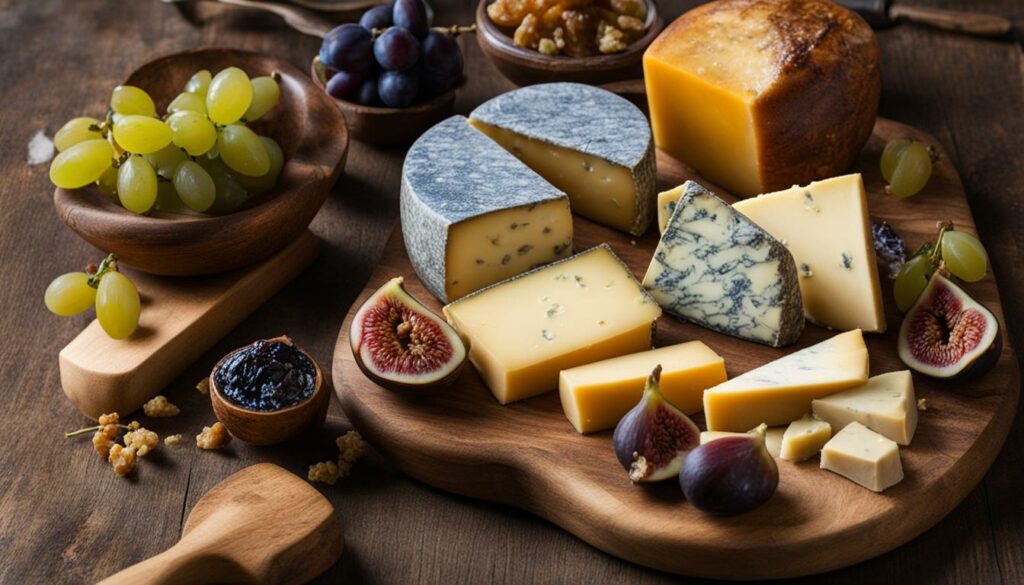
With its bold taste and versatile nature, blue cheese is a true delight to pair with different beverages. Whether you’re enjoying it with beer, wine, or spirits, the contrasting flavors create a memorable experience that will satisfy your cravings for a unique gastronomic adventure.
Tips for Storing and Serving Blue Cheese
Properly storing and serving blue cheese is essential to maintain its freshness and flavor. Follow these tips to ensure your blue cheese stays delicious:
Storing Blue Cheese
When storing blue cheese, it’s crucial to keep it in the coolest, driest part of your refrigerator. The crisper drawer is an ideal location. This helps maintain the cheese’s quality and prevents it from drying out.
Pro Tip: Blue cheese tends to have a strong aroma and might impart its flavor on other foods. Store blue cheese separately from other cheeses to avoid cross-contamination and preserve their individual flavors.
Wrap your blue cheese in cheese paper or wax paper to allow for proper air circulation. This prevents moisture buildup and mold growth, extending the cheese’s storage life.
Serving Blue Cheese
When it comes to serving blue cheese, there are several delicious options:
- Pair blue cheese with fresh fruits like apples, pears, or grapes to balance its richness with natural sweetness.
- Add a variety of nuts, such as walnuts or almonds, to provide texture and enhance the flavors of the blue cheese.
- Serve blue cheese with a selection of crusty bread or crackers to create a tasty and satisfying cheese plate.
- Incorporate blue cheese into your favorite recipes, such as salads, pasta dishes, or even burgers, for a burst of tangy and savory goodness.
Regardless of how you choose to serve it, blue cheese pairs exceptionally well with a range of beverages, including red wines, port, or even a hoppy IPA.
Pro Tip: For the best flavor experience, allow blue cheese to come to room temperature before serving. This brings out its complex flavors and enhances the overall taste.
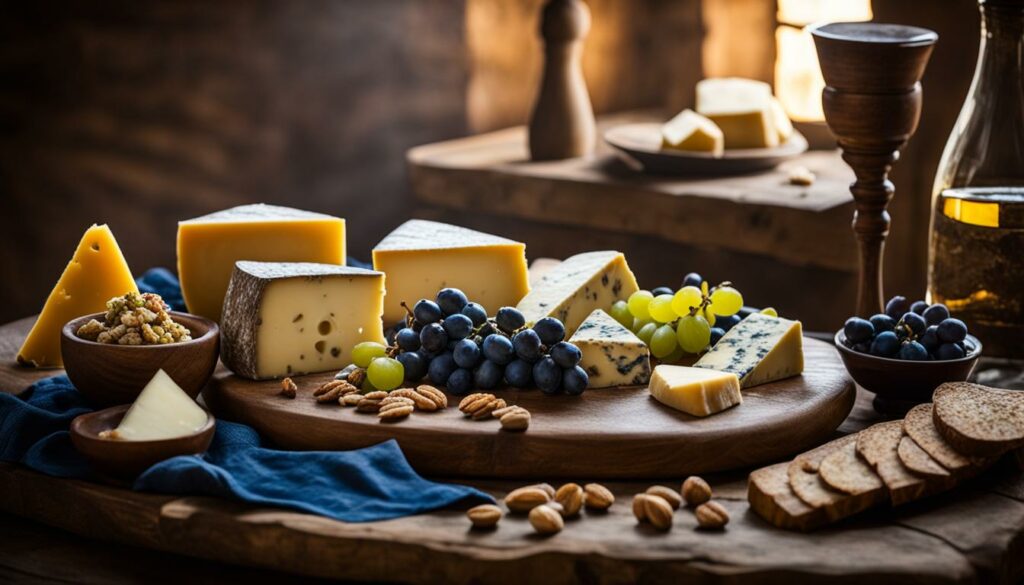
By following these storage and serving tips, you can ensure that your blue cheese remains fresh, flavorful, and ready to be enjoyed in a variety of delicious ways.
Conclusion
Blue cheese is a diverse and flavorful category of cheese that offers something for every palate. Whether you prefer mild and creamy blue cheeses or bold and pungent varieties, there are options available to suit your taste. Blue cheese pairs well with a variety of beverages and can be enjoyed on its own or as part of a cheese plate.
Experimenting with different types of blue cheese and pairing options will help you discover your favorite flavors. From the tanginess of Roquefort to the creaminess of Gorgonzola, each blue cheese brings its own unique taste to the table. Don’t be afraid to explore the world of blue cheese and find the one that satisfies your cravings.
With its rich history and unique production methods, blue cheese continues to be a beloved choice for cheese lovers around the world. Whether you’re indulging in a creamy Danish Blue or savoring the intense flavors of Bleu d’Auvergne, blue cheese is sure to leave a lasting impression. So, next time you’re in the mood for a distinctive and delicious cheese, give blue cheese a try and experience its incredible taste for yourself.
FAQ
What are some popular types of blue vein cheese?
Some popular types of blue vein cheese include Roquefort, Gorgonzola, Stilton, Danish Blue, Cambozola, Fourme d’Ambert, Cashel Blue, Maytag Blue, and Bleu d’Auvergne.
What is blue cheese made from?
Blue cheese is made using certain molds, such as Penicillium roqueforti, which give it its distinctive blue veining.
Is blue cheese suitable for cooking?
Blue cheese can be used in cooking or enjoyed on a cheese plate. It adds a unique flavor and creaminess to dishes.
What are the origins of blue cheese?
The origins of blue cheese are shrouded in legend and myth, but its creation involves the use of molds like Penicillium roqueforti or glaucum that break down the fat within the cheese, creating its distinct flavor and veining.
Are there different types of blue cheese?
Yes, blue cheese comes in a variety of types, ranging from crumbly to creamy. Some people may find crumbly blue cheeses more piquant and overwhelming, while others may prefer the milder, creamier varieties.
Which blue cheeses are worth trying from Wisconsin?
Some must-try blue cheeses from Wisconsin include Roth Buttermilk Blue, Deer Creek The Blue Jay, Hook’s Original Blue, and Carr Valley Glacier Penta Creme.
What does blue cheese taste like?
Blue cheese has a distinct taste that is salty, bright, and sometimes funky or earthy. It is bolder in flavor compared to milder cheeses like cheddar.
What beverages pair well with blue cheese?
Blue cheese pairs well with a variety of beverages, including beer, wine, and spirits. IPAs, fruity beers, bold wines like zinfandel, and botanical liquors like gin are all great options.
How should blue cheese be stored?
Blue cheese should be stored in the coolest, driest part of the refrigerator, preferably in the crisper. It should be wrapped in cheese paper to allow for air circulation and prevent spoilage.
How should blue cheese be served?
Blue cheese pairs well with fruits, nuts, and bread. It can be enjoyed on a cheeseboard or incorporated into various recipes.

